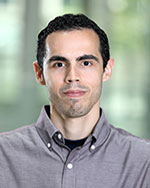
Dr. Alexander X. Cartagena-Rivera received a bachelor’s degree in Mechanical Engineering from the University of Puerto Rico at Mayagüez in 2010. Then he was a graduate student and research assistant in the lab of Prof. Arvind Raman at Purdue University. He received a Ph.D. in Mechanical Engineering from Purdue University in 2014. He accepted a Post-Doctoral IRTA Fellowship position in the lab of Dr. Richard S. Chadwick in the Section on Auditory Mechanics with the National Institute on Deafness and Other Communication Disorders at the National Institutes of Health in 2014. Dr. Cartagena-Rivera accepted a Tenure-Track Earl Stadtman Investigator position with the National Institute of Biomedical Imaging and Bioengineering (NIBIB) in 2019. He is now chief of NIBIB’s Section on Mechanobiology, where he and his lab staff continue work on understanding cellular and tissue molecular-mechanical regulation and development of advanced atomic force microscopy technologies for cancer biology and hearing research. In 2019 he received the prestigious NIH Distinguished Scholars Program award. His research interests lie in diverse and multidisciplinary fields including biomedical engineering, biophysics, fluid mechanics, soft matter, micro/nanomechanics, hearing mechanics, cellular biology, and living cells and viruses mechanics determined using the atomic force microscope in physiologically relevant conditions. Read more about Dr. Cartagena-Rivera's career in the NIH's Distinguished Scholars stories.
- Understanding the molecular-mechanical regulation of the actomyosin cortex of cancer cells and the solid tumor microenvironment (primary and metastatic) for deciphering self-organization in cancer biology.
- Understanding the anisotropic mechanical properties of developmental and mature inner ear sensory and non-sensory epithelial tissues using a novel noncontact AFM approach.
- Developing new AFM methodologies to study fast multiparametric and multidimensional cellular and tissue processes.
- Advancing the state-of-the-art AFM imaging methods for high spatio-temporal, multifrequency, and quantitative nanomechanical mapping.
